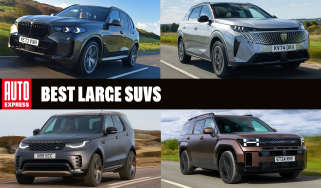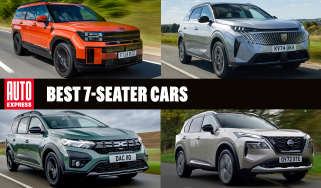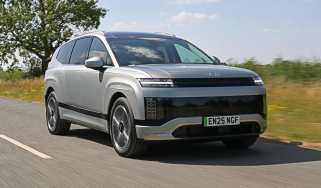Electric car towing test: the inconvenient truth about EV range with a trailer
Towing a caravan from Bristol to Land’s End with a Kia EV9: how hard can it be? Eight hours later, I was at my wits’ end…
You might think 60mph on the motorway is a recipe for EV efficiency. And when I charged Kia’s EV9 GT-Line AWD to 100 per cent in the early morning gloom, the trip computer displayed a reassuring 287 miles. More than enough for a 198-mile cruise from Bristol to Land’s End, a well travelled holiday-maker path. How wrong could I be?
The big SUV has only covered 60-odd miles at this steady pace, but the display is already predicting it’ll be touch and go to reach Land’s End. That’s what happens when you’re a 12-metre-long wagon train, with the seven-seat Kia hitched to a Bailey Unicorn Deluxe Cabrera caravan.
I’m overcome with flashbacks to the early 2010s, when a modest road trip in the pioneering Nissan Leaf electric car was more nerve-wracking than A Nightmare on Elm Street. A nightmare on every street, truth be told, with its 24kWh battery and about 100 miles of range.
Technologically, we’ve come a long way since then: the EV9 has a 99.8kWH battery and an official 316-mile range. And the charging network has made even greater strides: with tens of thousands of chargers firing out up to 350kW of Direct Current, long-distance motorway runs are typically uneventful in an EV.
But not, as it turns out, this one. I have the dreaded feeling we’re going to be mired in pit stops and shudder at the thought of trying to repeatedly hook up to chargers with a caravan behind. If only they had 12-metre bays with cables made of bungee ropes…
I glance in my extended side mirror – which surprisingly doesn’t crank up the wind noise and puncture the cushy EV9’s cruising civility, although its handy blind-spot detection system is sadly deactivated when a trailer is attached – and beyond the heft of my glacier-white caravan, I spy the similarly blocky form of the EV9’s sister SUV, the Hyundai Ioniq 9.
Colleague Ellis Hyde drew the short straw to tag along in our control car, to indicate what the journey would be like without a holiday home on our backs. The Ioniq 9 is fresh on the UK market, and shares the Kia’s chassis, battery tech and motors, but has a larger battery and in top-spec Calligraphy trim can travel a claimed 372 miles between charges. Both cars are all-wheel drive.
Ellis is probably sitting back in comfort, thinking we’ll be smoothly sailing to Land’s End. Time to puncture his bliss with a hands-free call…
How did we get into this spot? As Auto Express’ resident towing expert, I helped judge the 2025 Towcar of the Year, where the EV9 performed – like many of the big, grunty electric SUVs – absolutely brilliantly. But hauling in a test track’s controlled conditions left me wondering: what happens out there in the real world, jostling with jams, wipers on and off, air-con on and stereo blaring. Essentially, what does towing a caravan do to an EV’s range?
It’s 8:30 on the morning of a typical autumnal day: heavy showers one moment, pale sun 10 minutes later. Weather that makes EV charging – with the inevitable lack of shelter – a game of Russian roulette. We’re in the yard at Bailey of Bristol, a British manufacturer of leisure homes, with caravans and motorhomes of all shapes and sizes as far as the eye can see.
Our 20-minute across-town run after charging at Mollie’s Diner drains just five per cent. Official EV9 efficiency of 2.7 miles per kWh isn’t great – to be expected of a 2.6-tonne battery electric vehicle though – but I have no idea what’s about to transpire by attaching the Unicorn Deluxe Cabrera. It’s a single-axle unit that weighs in at 1,446kg, so well below the EV9’s 2.5-tonne maximum towing capacity. Its detachable tow bar is a £705 option and the 13-pin wiring kit for the all-important caravan lights another £285.
Lining up the EV9 and caravan is simple, helped by the car’s reversing camera and a brief swat-up on best practice via a Bailey instructional video. But getting back behind the wheel, the Kia’s range has been vapourised, slashed from 275 miles to 155 miles in the space of five metres backwards. Towing the Unicorn to Land’s End without charging could be as mythical as an actual unicorn. Still, that must be due to an overly cautious trip computer, right?
In convoy, we ease into the traffic of Bristol’s waning rush hour and make for the M5, heading south-west. With 378bhp and a whopping 700Nm of torque from its twin-motor set-up, the EV9 has the numbers to impress any caravanner. All that instant power from a standstill makes it easy to pull away from red lights, despite the Unicorn having dropped anchor.
This seems to surprise other road users, who probably expect the caravan in front to be a lumbering box on wheels, rather than one hauled by an electric Kia that can hit 62mph from standstill in just 5.3 seconds. It doesn’t feel much slower with its caravan load, as we hit the slip road and ease up to the regulated 60mph.
The EV9 settles into a refined cruise, with tyre grumble nicely suppressed. I keep away from the outside lane, a big no-no for anybody towing a trailer, and keep a regular eye on Ellis behind.
In the back of my mind I’m replaying dash cam videos of trailers weaving wildly as drivers attempt to regain control, but the Kia has Trailer Stability Assist to mitigate this. And its mighty kerbweight helps to shrug off the caravan’s mass, meaning my confidence builds that this combination feels rock solid.
It's a shame, therefore, that my confidence in its range isn’t improving, despite having left city stop-start for steady motorway rolling. In fact, efficiency takes a turn for the worse, if anything. So I make the call to Ellis…
Ellis’ view from the Ioniq 9:
The thought of spending five minutes stuck behind a caravan is enough to make my eyes start twitching. So, fed up with staring at the back end of a Unicorn, every now and again I open the taps on the Ioniq 9.
The power delivery isn’t as instantaneous or ferocious as a Tesla or other EVs: it’s calm and linear, with a slight delay from when I hit the throttle to it gaining speed. It's as if Hyundai programmed it to be like the way a big petrol or hybrid SUV with an automatic gearbox might accelerate. A novel idea, and it suits the car’s character.
But if you’re expecting the Ioniq 9 to waft along effortlessly like a Range Rover, you’ll be disappointed. It’s not uncomfortable by any means, but on the motorway the big loping Hyundai never settles down. It constantly bobs and sways more like a boat than an SUV, and going over large potholes upsets the car even more. It’s not overwhelmingly quiet inside either, especially on rough tarmac when noticeable road noise invades the cabin.
What’s this, a call from Dean…? We’re making an unscheduled stop at Exeter services. I might have to book the optician – at this rate, my eyes are going to be doing an awful lot of twitching…
Moto Exeter is well stocked with ultra-rapid chargers, with 50 Gridserve bays and up to 360kW on offer, as well as a total of 32 Tesla Superchargers. That’s all well and good, but the location of the chargepoints isn’t caravan friendly. For starters, the car park entrance has a 2.1-metre height restriction – which is too low for a caravan – so if you’re towing, you’re expected to stop in the longer lorry bays another car park away.
Would you really want to unhitch your caravan and leave it unattended while you drive around to charge your car? Probably not, but that’s what I have to do when we arrive around 11:30am. Thankfully, Ellis acts like a bodyguard, parking the Ioniq 9 in front of the caravan while I charge the Kia.
Inevitably, the rain starts falling, so I dash to the caravan for Ellis and I to cook up plan B. Land’s End is now 124 miles away, so surely we can make it on a no-stop strategy from here – even with a scenic detour to Dartmoor National Park?
Gridserve’s handy app informs us the EV9 is back to 100 per cent, so it’s time to hitch up again while Ellis charges. And naturally the rain is now absolutely teeming, making reattaching the caravan far less pleasant than at sunny Bailey's earlier.
More annoyingly, I spot a second, taller entrance to the chargers on the way out, but it’s a very tight manoeuvre for a caravan – especially if the services are busy with other cars. It contains an oasis of more spacious charging bays, though seemingly designed for wheelchair users rather than caravanners. We give it a whirl and our circus overhangs the bay front and rear. So the ‘easier’ option is to do the unhitching dance. Charging on the go is becoming easier for the average EV driver – but not if you’re towing…
With a full charge in both cars – 167 miles for me, with Ellis luxuriating in 347 miles – we hit the road again. We take the Devon Expressway, then after 17 miles turn off for Dartmoor. Which, it turns out, is a Big Mistake.
At nearly two metres wide, the EV9 is a bulky machine, but it’s slim when compared with the Unicorn’s 2.3-metre girth. The thick hedges feel like they’re closing in on us and I’m worried about scratching the Bailey, or shearing off one of the extended mirrors, which clamp onto the regular ones. So I decide to turn around (not easy when your set-up is around 12 metres long), and thread my way back to the wider main roads.
Back on the Devon Expressway, the EV9 does a good job of ironing out bumps, although larger ridges still resonate. A typical sensation in a car-and-caravan-combo is to feel bumps transmitted back through the car once the caravan crosses them, but in the EV9 it's barely an issue.
Every now and again, a trucker flashes me, in the nicest possible way: guiding me back into the nearside lane once I overtake their rig. Not an easy task because it’s hard to judge the caravan’s rearmost point. This road trip is teaching me a new sense of solidarity with drivers of lorries, which don’t seem much bigger than me.
On we push, sticking to 60mph, or 50mph on single carriageways, but the EV9’s trip computer remains resolutely pessimistic. Not once has it topped the 2.0 miles per kWh mark, and after a steep climb it dips as low as 1.4mi/kWh. Bear in mind the EV9’s official figure is 2.7 mi/kWh – and I’d seen 2.9 on the drive to Bristol to prepare for the test. All the while, I regret cramming the boot with heavy suitcases to simulate a typical holiday load: method caravanning if you will.
Meanwhile in the Ioniq 9, Ellis is conserving energy with his self-imposed 60mph maximum, so much so that he probably could have trekked to Land’s End and back to Bristol without issue.
Ellis’s view from the Ioniq 9:
Without a shred of range anxiety, I take the opportunity to assess the Hyundai's features. Despite deactivating a few ‘assistance’ systems, the amount of times the driver monitoring encourages me to “take a break” makes me think it was sponsored by Kit Kat. Briefly covering the camera stops the warnings, randomly.
The further west we go, the better the weather. Crossing the Tamar Bridge gives me a buzz of positivity, despite the nav saying 82 miles to our destination. But soon, the anxiety kicks in again, when the EV9 bongs a warning – with 40 per cent charge. When not towing, it waits until 20 per cent. Closing in on Penzance, I get back on the Bluetooth to Ellis, anxious that I need another
stop. Maybe it’s the exuberance of youth, but Ellis persuades me to hold out for Land’s End. Against my judgement, we plough on, the range dropping faster than ever – 30 miles, 20 miles – so I slow my speed to around 50mph. The only vehicles I get to overtake are tractors, which isn’t great for a road tester’s self-esteem. Eventually, the ratio swings back in my favour – we haul up to Land’s End with just eight miles of range to spare.
The attractions are closed – but the upside is there’s space to park. Over our eight-hour odyssey, the EV9 averaged 1.5 miles per kWh, pretty much half the Ioniq 9’s 2.9 mi/kWh. The worst aspect is the knock-on effect of charging, which can be a fiddly, time-consuming nightmare when towing, which is a definite skill, and I have respect for those who do it – especially with an EV.
We admire the sea view and wallow in the achievement – before using the modest 60kW Osprey chargers. No Moto niceties this time: I block them in with the caravan, figuring I could move it by hand if needed. After that journey, I wasn’t fussed about being an inconvenience – especially with the return leg still to come.
Tester notes (Dean)
We were fortunate enough to be able to use the same EV9 that I drove on the Towcar of the Year test, so I was familiar with its ability when a caravan on the back. It has a 99.8kWh battery that offers a range of 316 miles in GT-Line AWD guise. The rear-wheel-drive Air model can go further, but it has a far lower maximum towing capacity at 900kg, compared with 2,500kg for the AWD models.
Overall I'd say the worst part of my experience on this trip was the charging. The whole rigmarole of parking up, unhitching, going to top up the battery and then hitching up again was tedious, and having to reconnect the caravan in the dark or rain was a recipe for things to go wrong. Then there was the stress of leaving the caravan while charging. You never know who's about, so I'd recommend investing in a sturdy hitch lock for added peace of mind.
Tester notes (Ellis)
While the Ioniq 9 uses the same platform as the EV9, it's marginally bigger and has a slightly better drag coefficient (0.27Cd to the Kia's 0.28Cd). Battery size is 110.3kWh and more powerful electric motors are used, too. There's a range of up to 385 miles for the rear-drive model, but it can only tow 1,600kg, compared with 2,500kg offered by the top-spec Calligraphy we drive here.
Land’s End: the final reckoning
Kia EV9 + Bailey Unicorn
A return of 1.5 miles per kWh on our 129-mile route from Exeter to Land’s End gives the EV9 a range of 150 miles with a caravan attached, less than half the official WLTP-tested range. While the Kia proves that EVs are hugely capable when towing, it’s still a mammoth task to travel longer distances.
Hyundai Ioniq 9
Limiting the Hyundai’s top speed to 60mph helped with its efficiency over our test route, and we saw 2.8mi/kWh when we arrived at Land’s End. That means a range of 309 miles is on offer, and with 59 per cent capacity remaining when we arrived, Ellis could have easily headed back to Exeter without recharging.
The Bailey behind us
Our test wouldn’t have been possible without the generous assistance of British caravan manufacturer Bailey of Bristol. Its mid-range Unicorn Deluxe Cabrera costs £33,399 and is a four-berth model that features a double bed, a front lounge with the option of twin or double-bed sleeping, a kitchen with a fridge, a washroom, a separate shower, LED interior lighting, a digital TV aerial, radiator heating, a Sonos Bluetooth speaker and even a solar panel for extra power. At 2.26 metres wide, 7.3 metres long and 2.7 metres tall, it’s one of the larger single-axle caravans available on the market, but it proved a useful base in Exeter when revising our route, and helped us stay out of the wind at a blustery Land’s End upon our arrival. It’s typical of a ’van that an SUV owner may choose to tow.
Epilogue
The EV9 may have had next to no charge left by the time we reached Land’s End, but the Ioniq 9 still had 59 per cent left to go. So as the light faded, Ellis made a run for the Devonshire border and enjoyed the freedom of being able to drive at 70mph for the first time all day. He managed to make it all the way to Taunton services before needing to stop for a top-up.
Based on the Ioniq 9’s average efficiency of 2.9 mi/kWh, he’d have covered more than 300 miles from a single charge in the Hyundai – enough to get from London to Paris. Maybe we’ll try that next year – but staying in hotels instead.
It was a different story for Dean. It turns out the trip computer goes into a different mode when a trailer is attached, or when Trailer Mode is selected. Its range estimate isn’t based on trailer weights, so it’s a rough figure – and one that shaped the pit-stop strategy on the way back.
So after unhitching (again) at Camborne to use rapid 300kW chargers, Exeter services beckoned once more to top up with enough juice to get back to Bristol. However, an empty car park and vacant chargepoints meant it was less of a hassle than it was earlier in the day. Is night caravanning the way forward, perhaps?
Our dealer network has 1,000s of great value new cars in stock and available now right across the UK. Find your new car…
Find a car with the experts
















